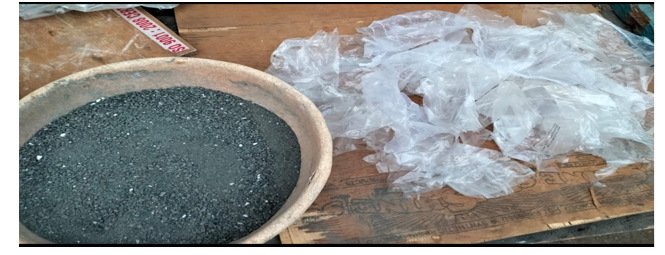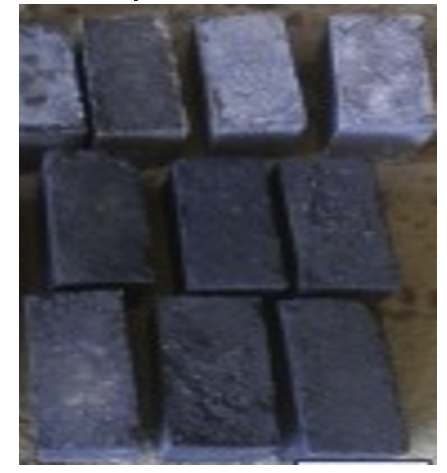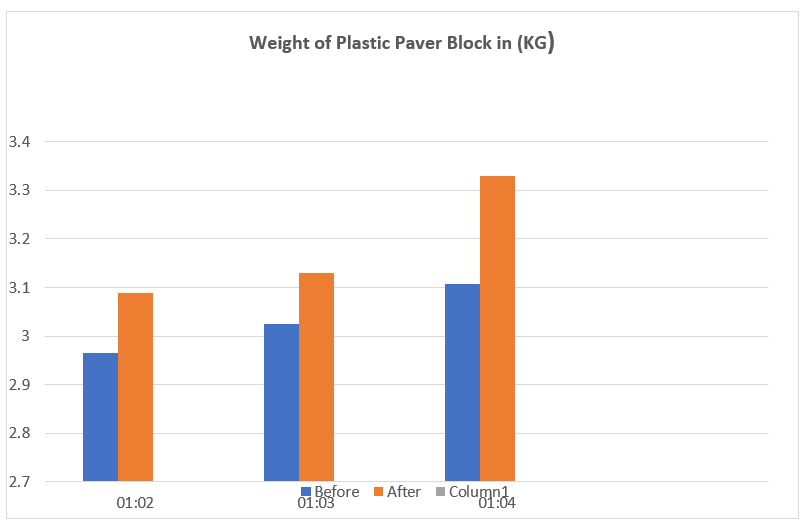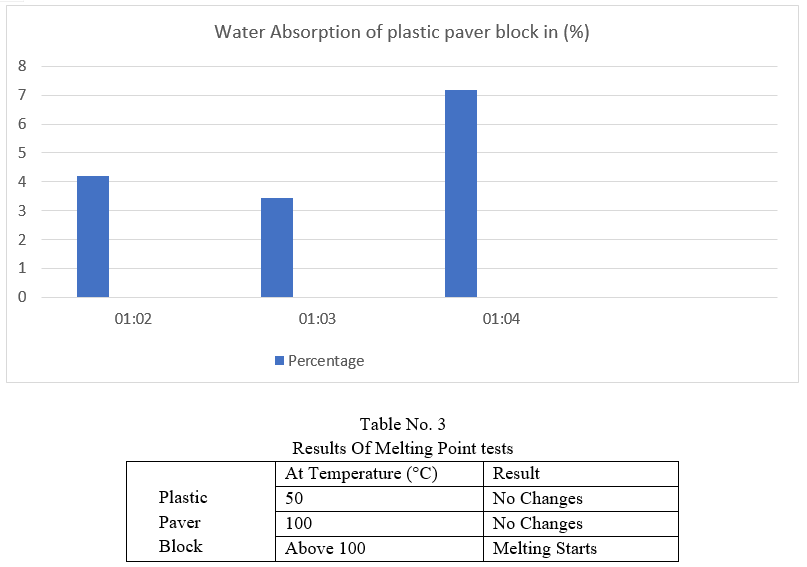Ijraset Journal For Research in Applied Science and Engineering Technology
- Home / Ijraset
- On This Page
- Abstract
- Introduction
- Conclusion
- References
- Copyright
Re-Use of Plastic in Paver Blocks
Authors: Jatin Ashok Patil, Monish Pravin Patil, Rohit Rajesh Patil, Rohit Shrikant Patil, Rutik Suresh Patil , Prof. Krishna A Joshi
DOI Link: https://doi.org/10.22214/ijraset.2022.41357
Certificate: View Certificate
Abstract
A massive variety of plastic wastes were amassed from several places which includes tourist and public places and so forth., plastic baggage are collected, cleaned, and used as a substitute for cement within the production of paver blocks. Plastic waste is available in large amount and therefore the value thing comes down. Whilst we having waste plastic then we are able to use as reuse, recycle and reduce. understand of what you do, pay atten-tion to the items you purchase, and always check your self to peer in case you want it or if it comes in a package deal with much less waste. Plastic is a non- biodegradable cloth. The amount of plastic waste in municipal solid waste is increasing rapidly daily. Plastic is crafted from hydrocarbons de-termined in different sources like oil, coal and a few other minerals. on the time of want, plastic is observed to be very useful but after its use, it\'s far in reality thrown away, growing all sorts of risks. Plastic is of the numerous different sorts which includes high density poly-ethylene (hdpe), low density polyethylene (ldpe), hd, and so on. as a result, these waste plastics is to be correctly utilised in making paver blocks. Plastic are easy and delivered with the sand and aggregate at diverse percentage to gain excessive energy paver to ad-dress pollutants and to reduce the overall fee of construction.
Introduction
I. INTRODUCTION
Plastic is evil. you may rarely go faraway from with it. each day we use plastic in each day way of life that is rubbish, espresso cup, plastic bottles, plastic luggage and so on. So plastic is very harmful to human beings, animals, marine and as well as to surroundings. however wherein is all the plastic going?
It might be startling to note that billions of tons of plastic are finishing up in the international’s oceans. pollutants caused by plastic is not best harmful to marine life however is likewise affecting the fitness of human beings. the dangerous chemical compounds like pcbs, ddt, and pah, which get absorbed in the plastic particles that floats inside the seawater, have a varied and harmful variety of continual results like Endocrine issues.
The pollution are transferred inside the meals chain as they get absorbed within the animals’ bodies after they eat the plastic portions. human beings consume those infected fish and mammals. Plastic pollution is affecting the worldwide economy. it's far destroying the fishing and aquaculture industries.
Plastic is frequently produced by household, tourism and hiking etc. In many countries, the composition of waste is extraordinary, that it's far suffering from the socioeconomic characters, waste control packages, and intake styles, however usually, the extent of plastic inside the waste composition is high. one in every of the biggest additives of plastic waste is polyethylene that's accompanied through polypropylene. Endocrine issues. The toxins are transferred within the meals chain as they get absorbed within the animals’ bodies once they devour the plastic.
II. OBJECTIVES
The aim of this task is to update cement with plastic waste in paver block and to lessen the value of paver block whilst in comparison to that of convention concrete paver blocks. also different goals are as follows:
- Predominant goal is to use plastic as opposed to cement in making paver blocks.
- To determine the suitability of waste plastic within the development of pavement blocks
- To provide value-powerful paver blocks and Which a common person can have the funds for effortlessly.
- Additionally alternatively reducing the rely of plastic from our surroundings.
III. MATERIALS AND METHODS
A. Materials
- Plastic: Waste plastic from the household, functions, and so forth are cleaned and used. Natural nice combination (Sand): herbal River Sand is used. As a quality aggregate, combination passing throught 4.75mm is sieves.

B. Methods
- Compressive energy test: The compressive electricity check is carried on plastic paver block the decide the energy of paver blocks for expertise it suitability. The paver block is beneath beneath the everyday trying out device and the burden is applied on it.
- Water Absorption take a look at: This test is performed to determine the water absorption percent of plastic paver blocks. in this the paver block is first weighted in dry circumstance and then allow them to immersed in fresh water for 24 hours. After 24 hours of immersion, blocks are taken out of water and are wipe with fabric. Then the blocks are weighted in moist condition. And the difference between two weight is the water absorbed via plastic paver block.
- Melting point test: This check is executed to determine the melting factor of paver block i.e Upto how a lot temperature paver block can be remain unchanged. For this paver blocks are placed in oven for two hours with designated temperature to get the actual temperature at which our paver block melts.
IV. EXPERIMENTAL PROCEDURE
So, we are looking to organized 9-10 blocks for our venture with the diverse share of plastic and great mixture (sand)
Proportions of plastic and sand are as follows:
|
Proportion |
plastic in (kg) |
Sand (kg) |
|
|
|
As per ratio |
As per ratio + extra 15-20% |
|
|
1:2 |
1.04 |
1.200 |
2.070 |
|
1:3 |
0.775 |
0.900 |
2.325 |
|
1:4 |
0.62 |
0.740 |
2.48 |
Be aware: even as heating/melting the plastic, a few quantity of plastic is reduced. So because of this we had delivered greater 15-20% amount of plastic in real weighted plastic.
Steps for making plastic paver blocks are as follows:
- Step1: Sorting the plastics cautiously – plastic waste are amassed from damping sites/families. The plastic luggage have been smooth, free from different elements interior poly baggage. these baggage had been heated till it turns to viscous shape at a temperature about one hundred fifty to 160 degree celsius.
- Step2: Melting till the plastic grow to be black liquid – light a small hearth under the metal drum and gently heat it. add the plastic waste preserve including the plastic gently on the facet of the melted plastic until at melts right down to a black liquid.
- Step3: Mining sand into melt – keep mining very well till all of the plastic has steel and there's a constant black liquid. Stirring and heating have to hold till all lumps are eliminated and a homogeneous paste is received.
- Step4: pouring the mixture into moulds– put together the mold by making uses it's miles very clean, with no pieces of plastic on it. quick do away with the mixture using the spade with the steel shaft and placed into the mold.
- Step5: Urgent the aggregate tightly into moulds - allow the hot combination inside the mould to set for a couple of minutes, repeatedly shaking the mildew. keep looking to carry the mould. when the mixture has hardened sufficient that the slab will not crumble, remove the mold and go away.
- Step6: Doing away with the block from the moulds - tiles made on this way are as sturdy as concrete pairing tiles. These can be examined and certified as an authorized creation product.

V. RESULTS AND DISCUSSIONS
From the above check performed on plastic paver blocks with all 3 percentage we get below consequences:
Plastic paver block with percentage (1:3) gives excessive compressive energy outcomes. Its 28 days power is same to 38.70 n/mm2. Which indicates that it is able to be effectively used for non-traffic & light traffic regions.
- Water absorption of plastic paver block with share (1:2) & (1:3) is much less as compared to percentage (1:4). But proportion (1:3) offers better outcomes. as it suggests most effective 3.43% of water absorptions.
- Melting factor indicates equal consequences for all three proportion of plastic paver blocks and finish that the plastic paver block is suitable for our temperature. So sunrays will not make any consequences to our paver blocks.
VI. FIGURES AND TABLES
Table No. 1
Results of compressive strength tests
|
Plastic & sand Proportion |
Compressive strength of plastic paver blocks (N/mm2) |
||
|
|
7days |
14 days |
28days |
|
1:2 |
22.22 |
26.89 |
30.58 |
|
1:3 |
24.06 |
31.68 |
38.70 |
|
1:4 |
18.54 |
23.80 |
27.68 |



A. APPLICATIONS AND ADVANTAGES
- Applications
- Using waste plastic underway of paver square has gainful technique of removal of plastic waste.
- It can be utilized in gardens, platform, walking way and cycle way and so forth.
- Being non water permeable, the hazard of due, inexperienced growth and organism is nearly distributed with.
- It can be utilized in non-visitors and light visitors avenue. Five. By means of the use of the plastics in paver block, reduces the burden by 15%.
- It calls for much less a super opportunity to make.
B. Advantages
- It reduces the intake of sparkling raw materials.
- It reduces the water pollutants and the land pollution (from the land filling via decreasing the need for conventional waste disposal)
- It reduces the greenhouse gases emissions.
- It required less preservation or almost zero preservation.
- It's miles nearly 50% less expensive in comparison to concrete paver blocks.
Conclusion
A. The waste plastics may be used inside the paver block manufacturing. B. The utilization of waste plastic in manufacturing of paver block has effective way of disposal of plastic waste. C. It is able to be utilized in non-site visitors and mild site visitors avenue, gardens, pedestrian route, footpaths, rail-way platforms, and many others. D. It calls for less time for manufacture. E. Via the use of the plastics in paver block, reduces the burden up to fifteen%. F. Due to use of plastic in substitute of cement its cost is reduced to nearly 50% much less as compare to concrete paver block. G. Water absorption thru of plastic paver block is much less than concrete paver block, therefore proper drainage system may be required to take care of runoff. H. It has comparatively same life span as of concrete paver block. I. It required much less preservation or almost 0 preservation.
References
[1] Vishal kumar, dr. A.okay. Mishra, department of civil engineering, madan mohan malviya university of technology, gorakhpur, u.p., india- vol four, problem 4, (april 2016), issn: 2321-9653. [2] ganesh tapkire- p.g. Student, dept of civil engineering nri institute of studies & technology, bhopal, madhya pradesh, india.; satishparihar- hod, dept of civil engineering institute of research & technology, bhopal, madhya pradesh, india.; pramodpatil- p.g. Pupil, dept of civil engineering ssbtcoebambhori, jalgaon.; hemraj r kumavat– assistant professor, civil dept, rcpit shirpur, maharashtra. [3] nivetha, c. Rubiya, m. Shobana, s. Vaijayanathi, g. (2016). Production of plastic paver block from the solid waste. Arpn journal of engineering and applied technological know-how. 11(2) [4] ganesh tapkire. Satish parihar. Pramod patil. Hemra, r. Kumavat. (2014). Recycled plastic used in concrete paver block. International journal of studies in engineering and technology , poonam sharma. Ramesh kumar batra. (2016). Cement concrete paver blocks for rural roads. International journal of contemporary engineering and scientist studies, 3(1), 114-121. [5] joel santhosh. Ravikant talluri. (2015). Manufacture of interlocking concrete paving blocks with fly ash and glass powder. International magazine of civil engineering and technology, 6(four), 55-64. [6] praveen mathew et al., “utilization of plastic baggage in concrete block” literature overview june 2015, extent 2, problem 6 jetir (issn-2349-5162). [7] r.l.ramesh, “recycled plastics used as coarse mixture for constructional concrete” task reference no 37s1114. [8] mohan d.m, vignesh, “utilization of plastic bags in pavement blocks” volume 119 no. 15 2018, 1407-1415 issn: 1314-3395. [9] bhogayata a, arora nk. Green concrete from the publish-patron plastic wastes: indian situation. Ictset lawsuits. 2011 apr; 437–forty. [10] marzouk oy, dheilly rm, queneudec m. Valorisation of post-consumer waste plastic in cementitious concrete composites. Pubmed. U. S. National library of drugs. Country wide institute of fitness. 2006 might also; 27(12):310–6. [11] v. Kasselouri - rigopoulou, s. Gavela, s. Kolias “use of polymeric wastes inside the concrete manufacturing” polymers in concrete: a vision for the 21st century, cement & concrete composites 21: (1999) 449-452. [12] madam mohan reddy, ok, ajitha .b, and bhavani .r, “soften-densifiedpost customer recycled plastic baggage used as light weight aggregate in con-crete”,” international magazine of engineering research and programs (ijera) issn: 2248-9622 vol. 2, issue4, july-august 2012, pp.1097-1101.
Copyright
Copyright © 2022 Jatin Ashok Patil, Monish Pravin Patil, Rohit Rajesh Patil, Rohit Shrikant Patil, Rutik Suresh Patil , Prof. Krishna A Joshi. This is an open access article distributed under the Creative Commons Attribution License, which permits unrestricted use, distribution, and reproduction in any medium, provided the original work is properly cited.

Download Paper
Paper Id : IJRASET41357
Publish Date : 2022-04-10
ISSN : 2321-9653
Publisher Name : IJRASET
DOI Link : Click Here
 Submit Paper Online
Submit Paper Online

